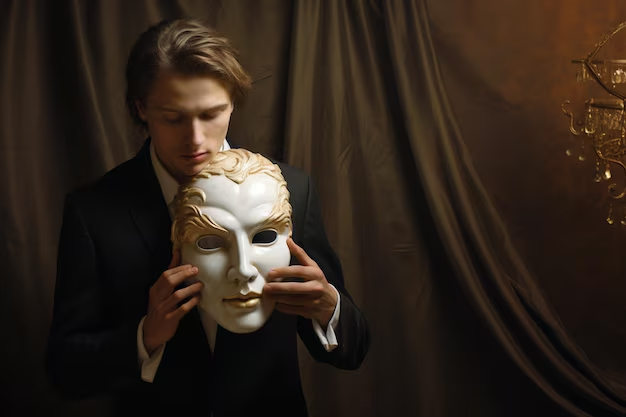Advertisements
Masks in theatre are not just stage props; they are the bridge between the actor and the essence of human emotion. They have the power to transform an ordinary performance into an enthralling experience, taking the audience on a journey deep into the human psyche. In this article, we explore how these ancient tools continue to play a crucial role in drama, influencing both the performance and the viewer’s perception.
Advertisements
Through a deep dive into the psychology of artistic expression, we will explore how masks can transcend reality and touch on the most fundamental aspects of human emotion. With origins dating back to ancient civilizations, these dramatic pieces have been used as a powerful means of communication, revealing and hiding emotions in complex and fascinating ways. Here, we will understand how this duality between the hidden and the revealed contributes to the construction of rich and engaging narratives in contemporary theater.
We will also explore the psychological impact that masks have on actors, allowing them to take on new identities and explore emotional depths more intensely. This game of hiding and revealing brings out nuances that are often impossible to express through the human face alone. Discover how this ancient practice continues to inspire and challenge artists around the world, while remaining relevant and essential in today's theater scene. 🎭

The History and Meaning of Theatrical Masks
Since time immemorial, masks have played a vital role in the art of theater. They are more than mere props; they are bridges to unknown worlds, portals that lead the actor to unexplored territories of their own emotions. Originating in Ancient Greece, masks were essential in the representation of tragedies and comedies, allowing a single actor to assume multiple roles. Over the centuries, this tradition has evolved, carrying with it the mystery and magic that only the expression of a masked face can evoke. 🎭
Advertisements
The Transformation of the Actor
When an actor dons a mask, a metamorphosis occurs. The mask acts as a catalyst, freeing the performer from the constraints of their everyday identity and enabling them to fully immerse themselves in the character. This phenomenon is often described as an almost mystical experience, where the line between “self” and “other” dissolves. This not only changes the actor’s appearance, but also alters his posture, voice and even his way of thinking, creating an environment conducive to a more intense and genuine performance.
The Psychology of Expressions
The power of masks lies in their ability to evoke deep and complex emotions in both performers and audiences. By covering the human face, the mask emphasizes other forms of expression, such as body gestures and vocal intonations. This forces the audience to engage more deeply, reading between the lines of movement and sound to capture the essence of what is being communicated.
Exploring the Unconscious
The mask acts as a mirror to the unconscious, revealing aspects of the self that often remain hidden. This concept is fundamental in Jungian psychology, where the mask (or “persona”) is a representation of the roles we assume in our interactions with the world. In theater, however, it provides a safe space to explore these repressed facets, allowing authentic, raw emotions to come to the surface.
- The mask releases the subconscious.
- Allows for a deeper connection with the audience.
- Amplifies gestures and voice, creating a unique experience.
The Cultural Impact of Masks
Masks are not just a tool for individual expression; they are powerful symbols that cross cultural boundaries. Around the world, they are used in rituals, celebrations and ceremonies, reflecting specific cultural traditions and values. In theatre, these cultural influences are incorporated, enriching the narrative and offering audiences a glimpse into the complex cultural tapestries that shape humanity.
Masks in Commedia dell'arte
In 16th-century Italy, commedia dell'arte popularized the use of masks in improvised performances. Archetypal characters such as Arlecchino and Pantalone are instantly recognizable by their distinctive masks, each carrying specific meanings and expectations. This form of theater still influences modern comedy, demonstrating the enduring power of masks in storytelling.
Masks in the Creation of Fictional Worlds
In addition to shaping emotion and interpretation, masks play a crucial role in creating fictional worlds. They allow the audience to be transported to imaginary places, where reality is suspended and stories come to life. Through the mask, the actor not only plays a character, but contributes to the construction of a narrative universe where imagination knows no limits.
The Archetypes and Their Masks
Archetypes, universal figures that inhabit the collective unconscious, find perfect expression through masks. Each archetype, whether hero, villain or sage, has a mask that symbolizes their intrinsic qualities and personal stories. By wearing these masks, actors can tangibly represent the forces and conflicts that drive the narrative, providing the audience with a visceral and engaging experience.
Conclusion
The essence of masks in theatre lies in their ability to transcend verbal language, communicating emotions and stories through visual and bodily expression. They are powerful tools that allow the actor to explore the depths of the human psyche, while connecting the audience to timeless and universal narratives. Each mask, with its unique shapes and colours, tells a story of its own, creating a vibrant mosaic of emotions and meanings that continues to fascinate and inspire artists and spectators around the world. 🌟

